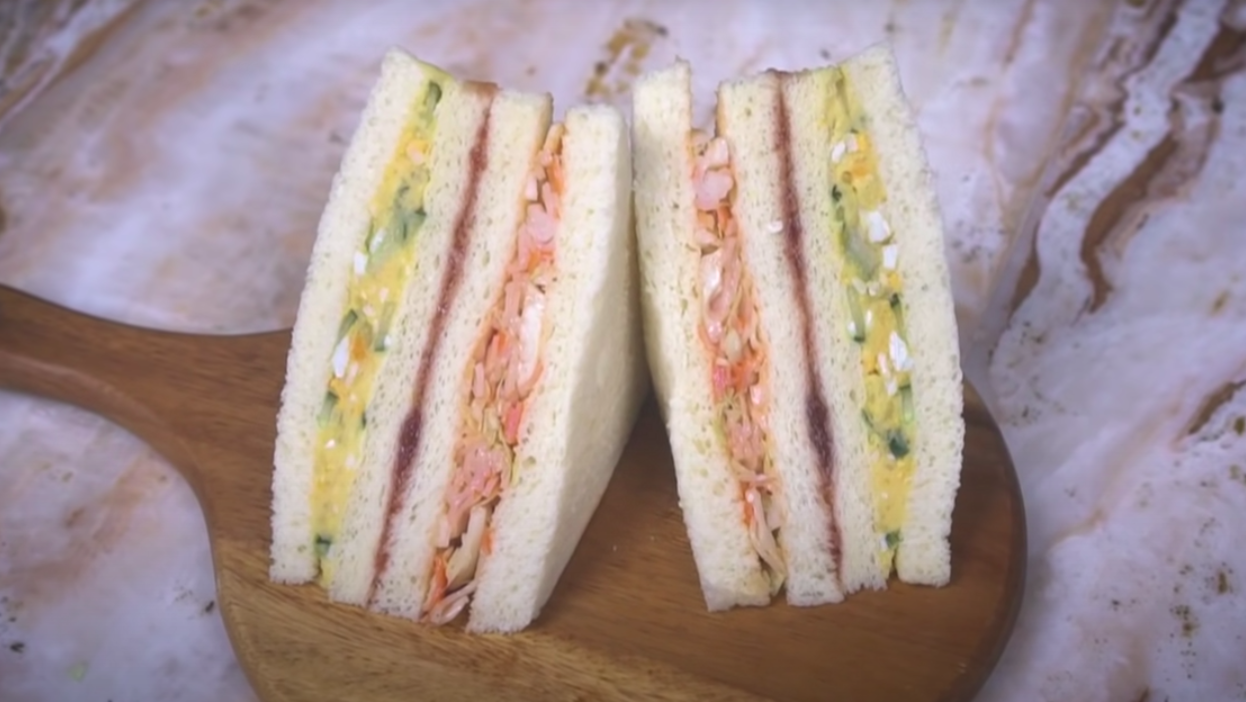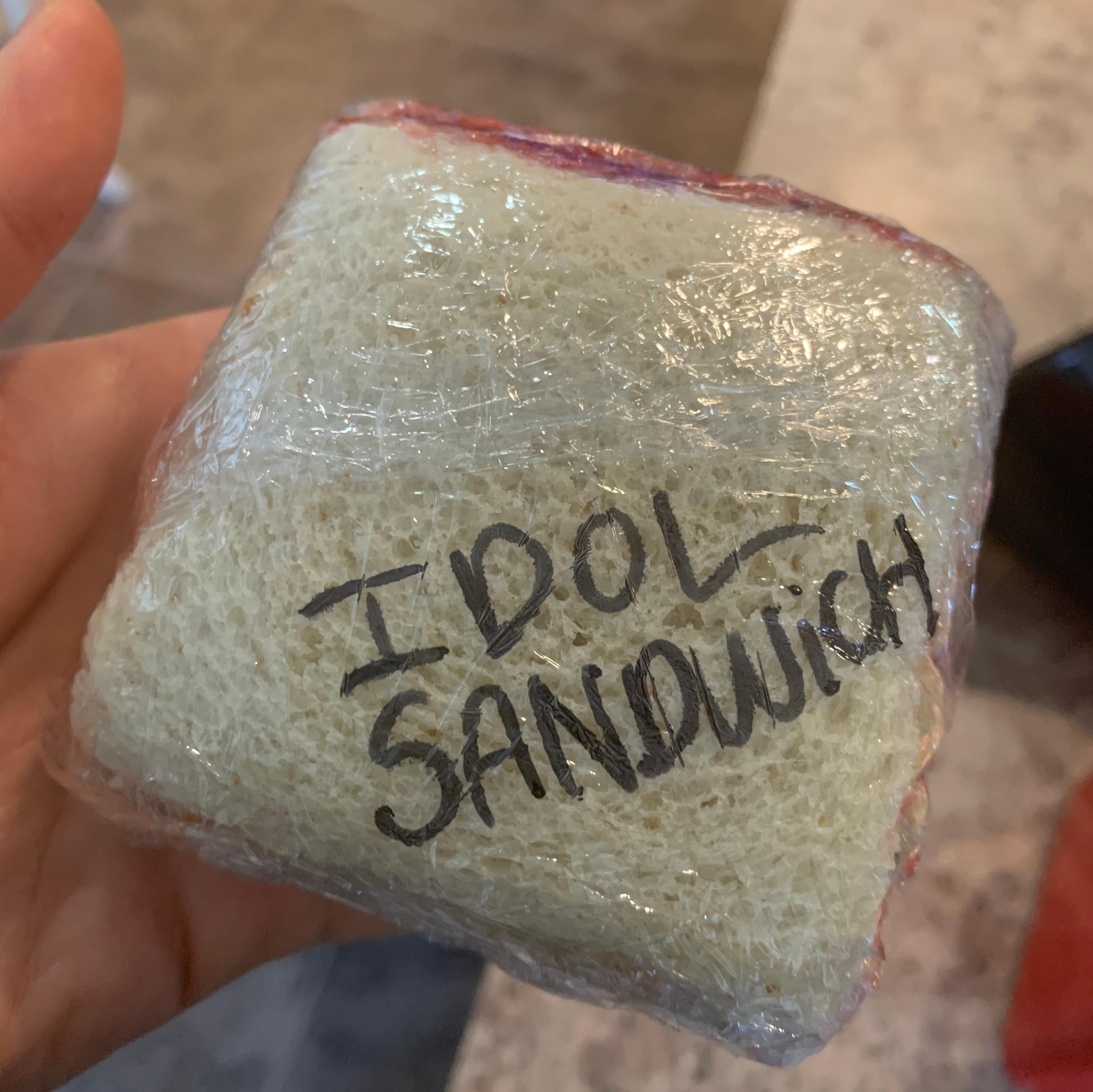The Inkigayo Sandwich Combines Egg Salad, Jelly, Crab, And K-Pop Pandemonium
How Korean pop music fandom hurtled an unlikely sandwich into the spotlight.
Somehow, despite its global takeover, I managed to resist the pull of Korean pop music (or "K-pop") for years. But after stumbling across the BTS song "Boy With Luv" after watching a YouTube video of their Saturday Night Live performance, I was hooked. It was the tiny shove I needed—well, that, and the fact that their 2021 summer hit was all about my favorite fat ("Butter," duh). Like magic, I became a Girl in Luv with BTS. And that's when I heard about the sandwich.
"Have you tried the K-pop idol sandwich?" texted a friend upon learning about my newfound infatuation. I had not, but Google was all too ready to enlighten me. The search results turned out to be the textbook definition of chaotic neutral, an oxymoronic interplay of a homey-looking comestible and these porcelain-faced stars posing with it so nonchalantly, so joyfully (hey, look, there's Suga! And Jimin!).
I came to learn that this sandwich had origins in the cafeteria in the building of South Korean entertainment network, SBS, which broadcasts the uber-popular K-pop performance show Inkigayo. Allegedly, only the pop idols and staff members can eat at this cafeteria, and because of this, the idol sandwich is sometimes also referred to as the Inkigayo sandwich.
What is the Inkigayo sandwich?
The sandwich features an unlikely combination of fillings. It's a triple-decker sandwich with three layers of thin fillings: potato-egg salad, strawberry jam, and cabbage surimi (imitation crab) coleslaw. These are ladled between four slices of crustless white bread and wrapped tightly in plastic, waiting to be scooped up by the stars.
It became a pretty well-known fact among ardent K-pop fans at the height of 2018 that the sandwich was the preferred performance fuel among pop idols, and a covert flirting tool. Seungri, member of the boy band BIGBANG, spoke of the backstage goings-on of Inkigayo during a radio interview, mentioning that "sometimes [one idol] would unwrap one side of the plastic, slip their phone number inside, and give [the sandwich] to [another idol]."
Naturally, shortly after this revelation, a frenzy of online fans created Twitter memes, speculated about the pop star love affairs the sandwich may have ignited, and tried recreating the sandwich for themselves.
Upon learning about the sandwich in 2021, I was immune to the mania it created back in 2018—or so I thought. What started as a joking "lol yeah I should make this" response to my friend's text quickly escalated into an insatiable, unexplainable craving to make and eat the Inkigayo sandwich. Following a simple recipe from the blog Christie at Home, my sandwich only took minutes to assemble, and then I wrapped it in Saran wrap for the maximal cafeteria effect. And because at that moment the impulse was irresistible, I took a Sharpie and scribbled "IDOL SANDWICH" on top in big, blocky letters. Don't ask why.
Unwrapping it again, I took a generous bite and was instantly hit by a perplexing kaleidoscope of flavors. Bites were disconcerting, seesawing without a break between tremendous salt bombs and Gushers-like jam bursts. I let it settle into a perplexing aftertaste, wondering what exactly I had expected going into it. One could argue that the flavors were representative of the intricacies of the K-pop genre: a wild melange of different music styles and sounds that in the wrong hands would render cacophonous noise but somehow work beautifully together in the right orchestration. Or maybe I was thinking way too deeply about a mediocre cafeteria sandwich. Maybe, since I had just housed four slices of bread, I simply needed a nap.
In South Korea, companies cashed in on the concept of the Inkigayo sandwich to meet the consumer demand. Major South Korean convenience store chain GS25 released its own version, marketed as the "idol sandwich." Fans got their skates on and in the two months following the item's release in September 2018, GS25 stores across South Korea sold over five million Idol Sandwiches making it the number one food product by revenue, an episode the company claims to never have happened before with a sandwich product in its sales history.
"Tapping into the curiosity factor by releasing a product that was going viral on social media as creating taste and flavor that everyone can enjoy has made the product very popular," explained a representative from GS25 in 2018.
All in all, it was hard to parse the sandwich's hype and what consumers (myself included) were subconsciously seeking from it, even if they were huge K-pop fans. I thought back to the recently released McDonald's BTS Meal, with its specialty sauce and iconic Borahae purple packaging. The meal sold predictably well and spurred me to end my four-year abstention from the Golden Arches. Sometimes, the BTS influence isn't even deliberate: in a rather famous 2019 incident, BTS member Jungkook casually mentioned his affinity for a certain Downy liquid detergent scent on a fan webchat, and almost immediately, there was a run on the stuff: supplies meant to last months sold out in just a few days. Just when I was beginning to think the BTS effect had dwindled, the band recently led Chipotle to change its Twitter name to Chicotle.
What we consume in the name of K-pop, or another pop culture sensation, provides the perception of access that bolsters feelings of heightened closeness. Seemingly ho-hum products can bind fans to their idols, because they're sharing a sensory experience with an otherwise unknowable person.
Yet even with my newfound awareness of such artifice, I still felt the idol sandwich harbored some magic that only I was missing out on. Were my salad and jam fillings spread incorrectly? Or maybe the homemade experience can't compete with the mass-produced genuine article? To test that theory, I asked my cousin in Seoul to try a convenience store version. Upon tasting it, he, too, was puzzled by the hype.
"Why would I think of BTS when eating a sandwich?" he texted during his taste test. "It was good but I can't say it was super delicious...The medley [of fillings] was a combination of sweet-salty flavors Korean people typically like."
The Inkigayo sandwich craze might not have much to do with actual deliciousness—but it's a food that has undeniably been imbued with meaning by ardent fans. Nestled in between those three layers of fillings is the lore of the sandwich as a covert love letter system, a humble food enjoyed by a subset of glamorous stars, an edible behind-the-scenes glimpse into an immensely popular celebrity ecosystem that we can all experience for ourselves.
Before fully retiring from this escapade and returning to humdrums PB&J, I wanted to check in on where the real Inkigayo "Idol" Sandwich stands today. Some speculations, including one from Korean-American pop star Eric Nam, lead to the crummy news that the sandwich had since been removed from the Inkigayo cafeteria menu due to the exit of the cafeteria owner/manager who conceived the original sandwich recipe. Other thoughts and suggestions presume that the sandwich's popularity has faded as other new delicious menu items have been introduced.
To my fellow K-pop fans and the K-curious, don't let what I've said discourage you from trying the Inkigayo sandwich for yourself. Or better yet, let it exist in the fluffy, bready insulation of your mind—speaking from experience, I think that's the way to go.
Ask not whether it tastes "good" or "bad." Instead, focus on the more productive question: Which K-pop idol would send you their phone number through an Inkigayo sandwich?

